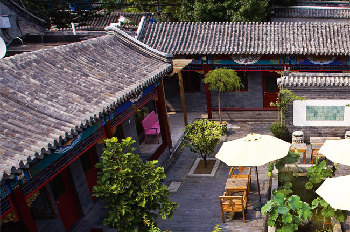Shen shares a popular dream of owning a quadrangle home in Beijing. Her dream has come true but it has cost her over six million yuan.
Chinese, who spent their childhood in a quadrangle home and wish to relive it are obsessed with Beijing's unique housing opportunities. Quadrangle housing attracts many different types of buyers: some overseas Chinese are wanting to live out their twilight years in a quadrangle home they remembered growing up in and always loved, and others are even buying into them as investment opportunities. No matter what the reason, the houses are all part of a list put out by the local government that encourages individuals or organizations to buy the quadrangles in old city areas.
|

|
|
Quadrangle, a type of housing unique to the capital, can best display the Beijing’s age-old history and unique culture. [file photo]? |
Shen's 200-square-meter dream quadrangle home is located at the border of Shi Chahai, where most of Beijing's high-price quadrangles homes are located and where former prince and royal residences can be found.
Shen spent three years working on the relocation of seven households before the planning, designing, applying for approval, and construction could take place. She oversaw every detail, from the layout of houses and wood structures, to carving on window mullion and eaves; the courtyard costs over six million yuan (US$877,977).
"I saw a new quadrangle 'growing' out of the earth," said Shen. She hopes to preserve the traditional cultural elements and restore the home to its original antique beauty.
Although quadrangle housing costs a pretty penny and requires painstaking efforts, the scarcity and non-replicable qualities still make the housing attractive to those who can afford it.
Statistics show that the per-square-meter price for quadrangle housing has risen from 5,000 yuan (US$731) in 1999, to as high as 30,000 (US$4,388) and 100,000 yuan (US$14,626) currently. A 600-square-meter quadrangle in the Shi Chahai area could cost over 100 million yuan (US$14.63 million).
Beijing now has only 20,000 quadrangles homes left and they are scattered about 430 hutongs (or alleys), in old city areas; only 658 of them are listed as protection sites. Well preserved and intact quadrangles are very scarce since many were pulled down during The Cultural Revolution and during the large-scale renovation of Beijing's old city.
Preservation and renovation of these quadrangle homes requires a huge amount of money. The Beijing municipal government has been taking great strides in recent years including a 2.75 billion yuan (US$402 million) investment to repair old houses in the quadrangle sector. But the money could only repair six percent of the homes that need urgent maintenance; most of others are left uncared for.
The new government policy intends to encourage individuals and organizations to buy those quadrangles and convert them into high-class residential housing. This allows them to be preserved for hundreds of years to come.
(China.org.cn by Zhang Yunxing June 17, 2009)